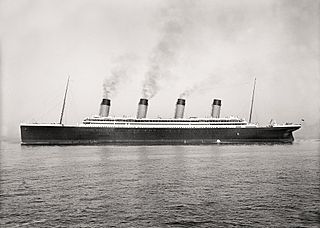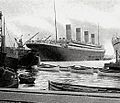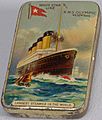RMS Olympic facts for kids
|
RMS Olympic on her sea trials in Belfast in 1911
|
|
Quick facts for kids History |
|
|---|---|
| Name | Olympic |
| Owner | |
| Port of registry | Liverpool, United Kingdom |
| Route | Southampton to New York City |
| Ordered | 1907 |
| Builder | Harland and Wolff, Belfast |
| Cost | $7.5 million (USD) ($195.1 million in 2018) |
| Yard number | 400 |
| Laid down | 16 December 1908 |
| Launched | 20 October 1910 |
| Completed | 31 May 1911 |
| Acquired | 31 May 1911 |
| Maiden voyage | 14 June 1911 |
| In service | 1911 |
| Out of service | 1935 |
| Identification | |
| Fate | Retired at Southampton after 24 years service & scrapped. Superstructure dismantled at Jarrow, England, and the hull at Inverkeithing, Scotland. |
| Status | Scrapped |
| General characteristics | |
| Class and type | Olympic-class ocean liner |
| Tonnage | 45,324 gross register tons; 46,358 after 1913; 46,439 after 1920 |
| Displacement | 52,067 tons |
| Length | 882 ft 9 in (269.1 m) |
| Beam | 92 ft 9 in (28.3 m) |
| Height | 175 ft (53.4 m) (keel to top of funnels) |
| Draught | 34 ft 7 in (10.5 m) |
| Decks | 9 decks (8 for passengers and 1 for crew) |
| Installed power | 24 double-ended (six furnace) and 5 single-ended (three furnace) Scotch boilers. Two four-cylinder triple-expansion reciprocating engines each producing 15,000 hp for the two outboard wing propellers at 75 revolutions per minute. One low-pressure turbine producing 16,000 h. 59,000 hp produced at maximum revolutions. |
| Propulsion | Two bronze three-bladed wing propellers. One bronze four-bladed centre propeller. |
| Speed |
|
| Capacity | 2,435 passengers |
| Crew | 950 |
| Notes | First in a trio of Olympic-class ocean liners for White Star Line and the only one to have a successful career. Elder sister to RMS Titanic and HMHS Britannic. |
RMS Olympic was a British transatlantic crossing ocean liner, the lead ship of the White Star Line's trio of Olympic-class liners. Unlike the other ships in the class, Olympic had a long career spanning 24 years from 1911 to 1935. This included service as a troopship during the First World War, which gained her the nickname "Old Reliable". She returned to civilian service after the war and served successfully as an ocean liner throughout the 1920s and into the first half of the 1930s, although increased competition, and the slump in trade during the Great Depression after 1930, made her operation increasingly unprofitable.
Olympic was the largest ocean liner in the world for two periods during 1911–13, interrupted only by the brief tenure of the slightly larger Titanic (which had the same dimensions but higher gross tonnage owing to revised interior configurations), before she was then surpassed by SS Imperator. Olympic also retained the title of the largest British-built liner until RMS Queen Mary was launched in 1934, interrupted only by the short careers of her slightly larger sister ships.
The Olympic was withdrawn from service and sold for scrap in 1935; demolition was completed in 1937. Decorative elements of Olympic were removed and sold at auction before she was scrapped, and now adorn buildings and a cruise ship.
By contrast with Olympic, the other two ships in the class, Titanic and Britannic, did not have long service lives. Titanic collided with an iceberg in the North Atlantic on her maiden voyage and sank, while Britannic struck a mine and sank in the Kea Channel in Greece in 1916. Britannic never served her intended role as a passenger ship.
Images for kids
-
Olympic (left) being manoeuvred into dry dock in Belfast for repairs on the morning of 2 March 1912 after throwing a propeller blade. Titanic (right) is moored at the fitting-out wharf. Olympic would sail for Southampton on 7 March, concluding the last time the two ships would be photographed together
-
Olympic photographed near the Isle of Wight in October 1912, six months after the Titanic disaster
-
Olympic in dazzle at Pier 2 in Halifax, Nova Scotia painted by Arthur Lismer
-
Olympic (left) and Mauretania (right) laid up in Southampton prior to their scrapping
-
Olympic arriving at Jarrow for scrapping on 13 October 1935
See also
 In Spanish: RMS Olympic para niños
In Spanish: RMS Olympic para niños

























